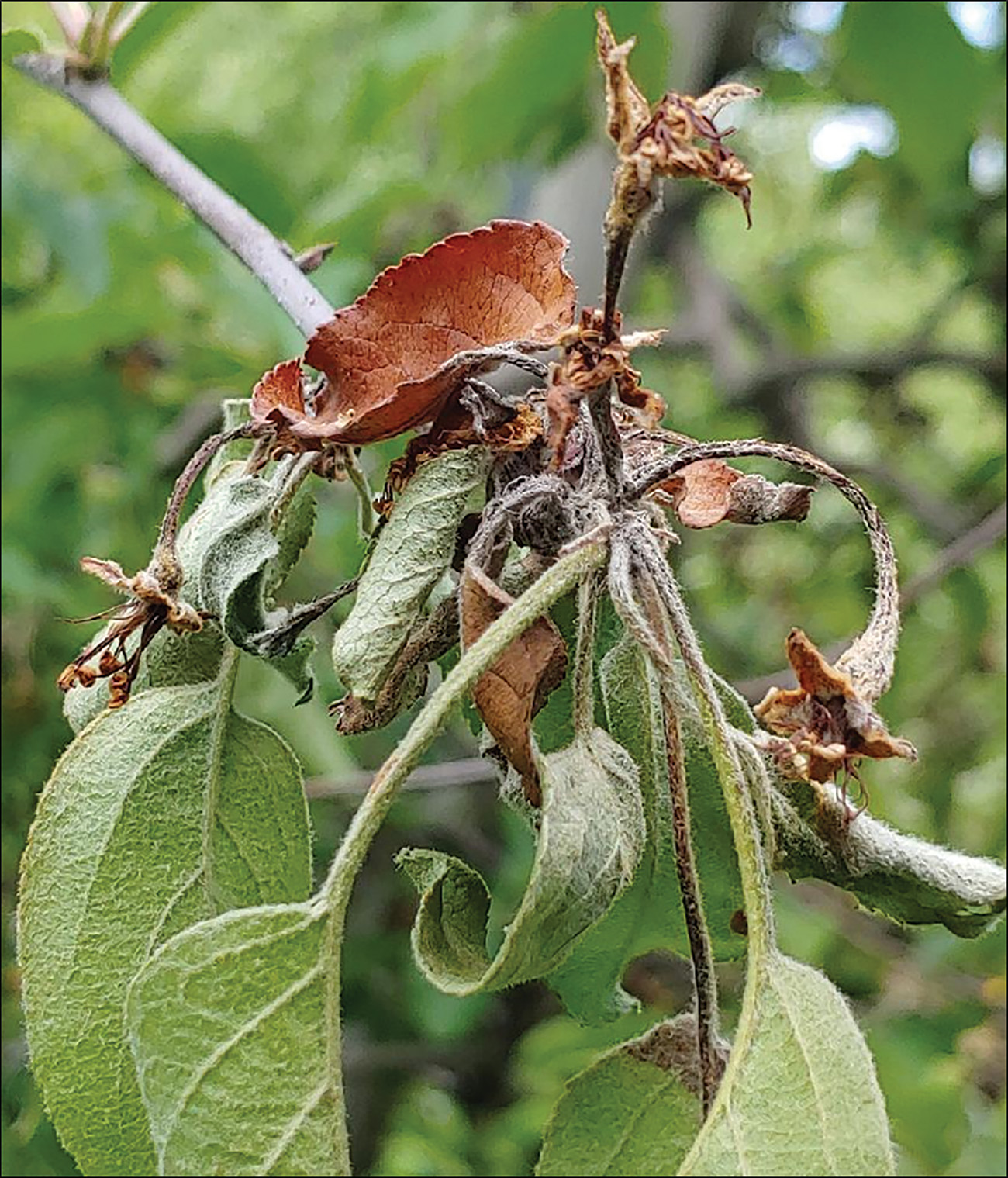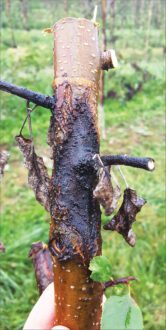

Jun 9, 2023Coast-to-coast research battles fire blight in apples, pears
Fire blight can cripple apple production and kill young trees. The disease is also difficult to control.
Researchers at Virginia Tech’s Alson H. Smith Jr. Agricultural and Extension Research Center in Winchester, Virginia, are studying methods to fight the contagious fire blight bacterium Erwinia amylovora, which is often deadly to trees. It affects apples and other pome fruits, including pears.


“It is really a big problem, this disease,” said Srdjan Acimovic, assistant professor in Virginia Tech’s College of Agriculture and Life Sciences’ School of Plant and Environmental Sciences. “That’s the one problem that keeps growers awake at night. It’s one of the most severe diseases. It also keeps us awake because we try to get the funding from the agencies and commodity groups to work on fire blight. We have many different ideas we try to test.”
Researching fire blight management methods, Acimovic’s lab evaluates and creates materials, including spray options, that target the bacterium. USDA grants fund projects designed to develop effective dormant copper spray treatments in a mix with bark-penetrating oils for eradication of fire blight bacterium in fire blight cankers.
The grants also fund research examining sprays with plant activators that prevent shoot blight and fire blight cankers, and test new antimicrobial enzymes. Some of the enzymes fight bacteria in clinical settings and in food processing facilities, degrading biofilm of the bacterium to control blossom and shoot blight.
The window of infection is during bloom — flowers are the pathogen’s entry point. Trees are also highly susceptible to infection during growth of shoots. The disease can jump from flowers to shoots and shoots can be infected independently. The disease also overwinters. Little is known about how fire blight remains during the winter, Acimovic said.
Once symptoms appear, however, the devastation becomes a crisis, Acimovic said. Symptoms can include brown or black leaves and shoots bending downward. Fruit turns dark and shrivels into mummies. Infected branches display creamy light-yellow ooze droplets.
Limited control
Pruning remains the only cultural practice growers can use to control fire blight. In early spring, copper can be sprayed until green tips reach a quarter-inch.


are studying ways to manage fire blight.
Humidity combined with high temperatures create conditions ideal for disease transmission. East Coast and Midwestern states sustain the most incidences. Because of Washington’s desert region growing conditions, rare wet springs pose lesser threats to the region, he said.
Accumulated rain events during wet springs, however, can wash away copper residues which can make the sprays less effective in preventing fire blight, he said. In pruning, growers may miss some infections in mature orchards that grow apples in modern high-density growing systems.
Though there is an industry push to use biocontrol agents including Blossom Protect, such agents could be effective, but remain tricky to use, Acimovic said.
They require more grower knowledge to learn how to use them. Also, they’re sometimes not compatible with fungicides used to control other apple diseases. Some biological control agents are highly susceptible to fungicides.
Acimovic’s lab is developing other techniques including mapping cankers in the orchard.
“It’s not easy because those materials are quite strong, and they can also damage the plant, Acimovic said. “Plant pathogenic bacteria are quite tricky. They are very resilient single-cell organisms that have been on this planet for much longer than humanity. So, they are very capable of surviving adverse conditions, including the measures we apply.”
Spray resistance One challenge is resistance to streptomycin, the primary spray growers use to control fire blight, which reduces the efficacy of sprays. Oxytetracycline, another treatment, has also sustained resistance.
“So this is a huge problem,” he said. “There is a concern in the grower community that it’s only a matter of time before this antibiotic is either ineffective or withdrawn from the market by the EPA because of the scrutiny the antibiotic use has in the medical side of things.”
Streptomycin is the only current antibiotic treatment that is affordable for the growers, Acimovic said.
Patience is required in the time-consuming search for solutions.
“Some of the things that we are looking at could potentially be revolutionary,” he said. “We’re combining everything that we can get our hands on and developing our own ideas to see if we can increase the efficacy of these materials.”
Advanced technology that detected SARS-Cov-2 and variants during the COVID pandemic is being deployed in Acimovic’s lab. The Droplet Digital PCR (polymerase chain reaction) detects small “fingerprint” regions of DNA molecules specific to Erwinia amylovora, saving researchers lab work.
To support the research, the USDA awarded Acimovic, the principal investigator, and his team of researchers at Virginia Tech and Oregon State University (OSU) a $75,000 USDA Specialty Crop Block Grant and a $287,000 USDA-National Institute of Food and Agriculture Crop Protection and Pest Management Grant.
Oregon’s contributions are vital because Washington is the largest U.S. apple state while the two states constitute the largest U.S. pear producing region, he said.
Acimovic is thankful for federal and state support of his research, including the Virginia Department of Agriculture and Consumer Services.
“That’s really important to allow this work to occur,” he said. “It’s critical, because it allows us to build up the level of knowledge, and then lead to a solution, and then outsource that solution to the growers.”
— Doug Ohlemeier, assistant editor
Top photo: Once fire blight symptoms appear, the disease quickly becomes a crisis in apple and pear orchards. The disease can jump from flowers to shoots and shoots can be infected independently.














